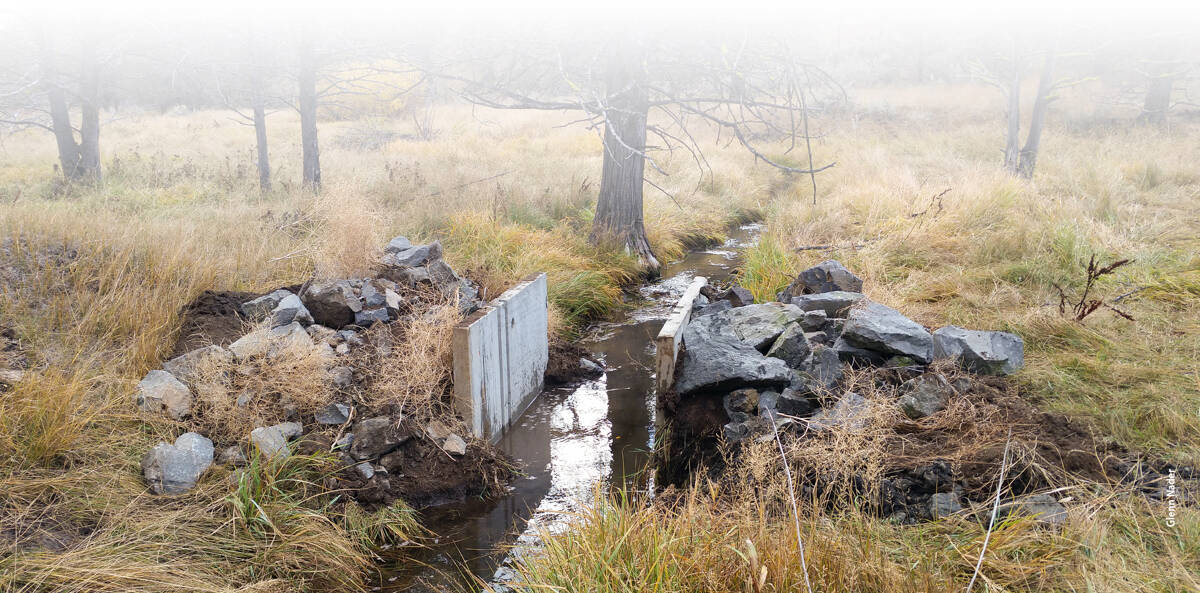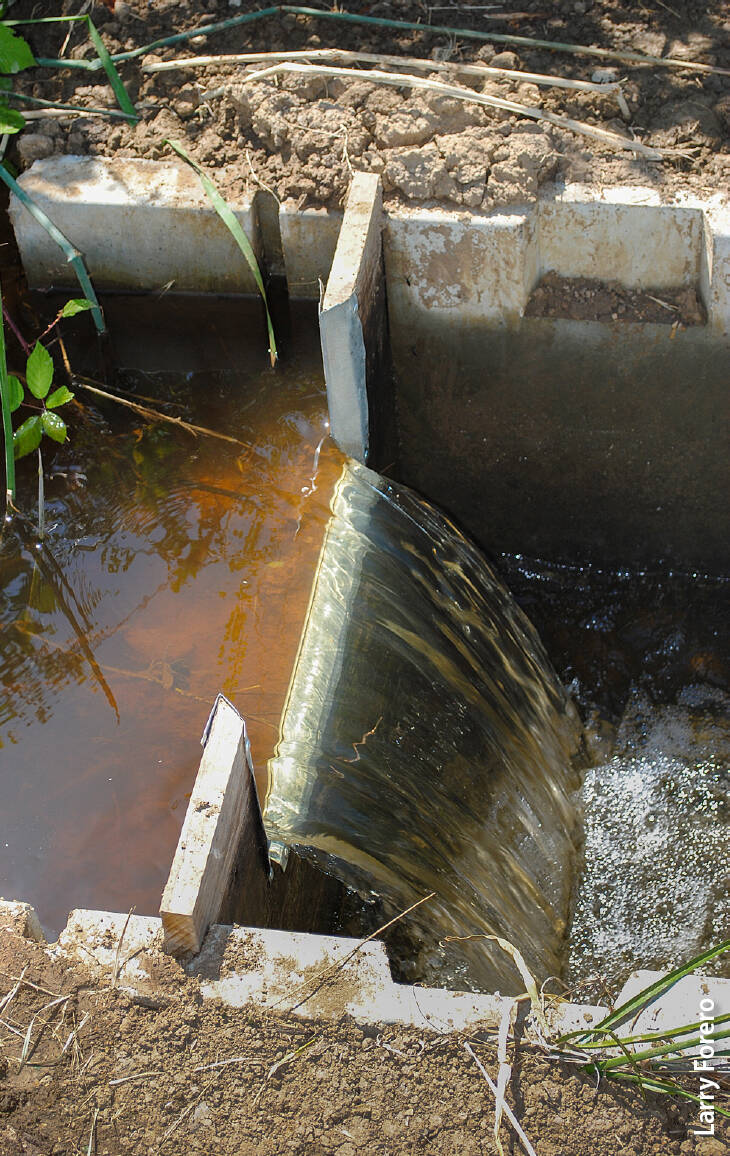All Issues
Do it yourself: UCCE workshop eases reporting of water diversions
Publication Information
California Agriculture 73(1):9-10. https://doi.org/10.3733/ca.2018a0043
Published online February 01, 2019
PDF | Citation | Permissions
NALT Keywords
Summary
For ranchers and farmers in remote locations, monitoring water diversions can present special challenges — that a new course helps overcome.
Full text
In recent years, California has tightened rules for reporting diversions of water for agriculture and other uses. One key challenge has been establishing workable standards for the collection of reliable data on relatively small and remote diversions — such as those for far-flung farms and ranches. Under new legislation, a certification program run by UC Cooperative Extension (UCCE) is helping to solve that problem.
The State Water Resources Control Board views accurate diversion reporting as a key element of sound water management. “It's incredibly important to monitor how much water comes into and goes out of the system,” says Kyle Ochenduszko, chief of water rights enforcement at the water board. Diversion reports are fed into a state database and support the orderly allocation of water resources by, for instance, enabling the board's Division of Water Rights to inform water users when new requests to appropriate water might affect their own supply.
Since 1966, the California Water Code has required diverters of surface water, with certain exceptions, to report their diversions to the water board. But in part because the water board lacked fining authority for many years, compliance was poor. In 2009, Senate Bill 8 gave the water board the authority to fine noncompliant diverters an initial $1,000, plus $500 for each additional day of failing to report.
A diversion site in Modoc County. A 2017 piece of legislation allows water diverters who complete a course offered by UC Cooperative Extension to install their own monitoring devices.
Even so, SB 8 did not stipulate precisely how diversions were to be monitored. Rather, it required diverters to measure their diversions using the “best available technologies and best professional practices,” unless they could demonstrate that such technologies and practices were not locally cost-effective. That is, the requirement left wide latitude for interpretation. So things remained until 2015 — when Senate Bill 88 became law. This piece of legislation, passed amid a historically severe drought, directed the water board to draw up emergency regulations regarding water diversions. The regulations, once completed, required diverters of at least 100 acre-feet of water per year to hire an engineer or appropriately licensed contractor to install all monitoring devices.
Now the requirements were clear. But the provision mandating installation by an engineer or contractor prompted an outcry from many smaller diverters, particularly those in remote areas of the state.
For most diverters near sizable towns — Redding, say — complying with the regulations was manageable, with expenses limited to the cost of a monitoring device and the services of an installer. But diverters in remote parts of Modoc County, for example, were looking at bigger bills, says Kirk Wilbur of the California Cattlemen's Association. For such diverters, compliance might require importing an engineer or contractor from far away, which would entail significant travel expenses. If a site lacked electricity, as many do, the costs would pile higher (electricity can be necessary in diversions that include a flow meter, or in data transmission from areas without cell service).
So how to reconcile the interests of the state's diverters with those of the state? How best to balance the public and the private good?
The answer, it turned out, was to empower diverters to install their own monitoring devices — with UCCE playing the empowering role. The idea originated with the Shasta County Cattlemen's Association. It gained the support of the statewide Cattlemen's Association. It took shape as proposed legislation in 2017 and was shepherded through the Legislature by Assemblyman Frank Bigelow (R-O'Neals). It breezed through both chambers with no votes in opposition — not even in committee. “All parties realized,” says Assemblyman Bigelow, “that Assembly Bill 589 would cut compliance costs and, as a result, increase compliance rates — which benefited both the regulators and the regulated community.”
A weir at the UC ANR Sierra Foothill Research and Extension Center in Yuba County. Once installation of a monitoring device for a weir is complete, water diverters need only read a staff gauge that shows the height of the water spilling over the weir's crest — and do a bit of math.
Essentially, AB 589 allows water diverters to install their own monitoring devices if they successfully complete a monitoring workshop offered by UCCE. Further, it directed UCCE to develop the workshop in coordination with the water board. Khaled Bali, an irrigation water management specialist at the Kearney Agricultural Research and Extension Center, took the lead in drafting the coursework. “Then we met with the [water] board and got feedback,” Bali says. “We made changes until they said, ‘This looks good.'” Attendees at the workshops, which last three and a half hours, gain a solid foundation in the basic principles of diversion monitoring. They learn how to monitor flows passing through a ditch, over a weir or through a pipe — or gathering in a pond. They learn how to build or install measuring devices appropriate for each type of diversion and how to calibrate those devices to comply with the state's accuracy requirements. They learn how to navigate the water board's rather detailed reporting system.
Equipment for monitoring flows through open ditches might be limited to a tape measure, a timing device and a floating object. Installing a monitoring device for a diversion routed over a weir — a simple dam with an edge or notch that allows overflow — requires a bit more equipment. But once the installation is complete, the diverter need only read a staff gauge that shows the height of the water spilling over the weir's crest (and then do a bit of math). Diversions flowing through pipes must be outfitted with flow meters. Diversions feeding into a pond or reservoir can be monitored by tracking the depth of the water with a staff gauge, float or pressure transducer (provided that the depth and surface area of the pond or reservoir are known).
So far, UCCE has offered the course in about 15 locations, from Yreka to Bakersfield. According to Shasta County UCCE County Director Larry Forero — who teaches the $25 course along with Bali, Tehama County UCCE Advisor Allan Fulton and UC Davis–based UCCE Specialist Daniele Zaccaria — about 1,000 people had earned certificates of completion by early October. Even farmers and ranchers who divert less than 100 acre-feet per year are attending. “I've been floored,” says Wilbur, “by the number of diverters who have attended the course even though they aren't required to — they want to better understand the regulations and make sure they're doing the right thing.” It probably helps that the registration fee is a fraction of the cost of importing a faraway engineer.






